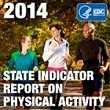Reports
This section provides links to key reports and recommendations that serve as the foundation for addressing physical activity.
State Indicator Reports
The State Indicator Report on Physical Activity, 2014 [PDF-2.8MB] presents information on physical activity behaviors and policies that encourage and support physical activity in states.

The report shows that physical activity among adults and high school students is higher in some states than others. Overall, most states have some supports in place that encourage physical activity, but more work is needed to increase opportunities for people to be physically active in their communities and schools. These supports may include state-level guidance on recess and physical activities policies in schools, walking or biking to and from school, joint-use agreements, and complete streets policies.
This report can be used to learn what states across the nation are doing to encourage and support physical activity and to identify opportunities for improving community supports in each state. Individual state Action Guides summarize each state’s data and provide suggested actions that state health departments can take to encourage and increase physical activity in their states.
State Indicator Report on Physical Activity 2010 [PDF-1.5MB]
The State Indicator Report on Physical Activity 2010 provides information on physical activity behavior and policy and environmental supports within each state. Physical activity, essential to overall health, can help control weight, reduce the risk of heart disease and some cancers, strengthen bones and muscles, and improve mental health.
Also available:
- The National Action Guide [PDF-237KB] summarizes PA levels among Americans and also provides potential action items to support state-level policy and environmental changes to increase PA.
- State Indicator Report on Physical Activity, 2010 Data Tables with Confidence Intervals [PDF-305KB] provides state-specific information summarized for each state’s physical activity levels and compared to the nation.
Surgeon General Reports
1996 Physical Activity and Health: A Report of the Surgeon General
U.S. Department of Health and Human Services
The 1996 Surgeon General’s report was the first to address physical activity and health.
Vital Signs
Adults with Disabilities: CDC Vital Signs
Being physically active is one of the most important steps Americans of all ages, shapes, sizes and abilities can take to improve their health. A new CDC Vital Signs™ report shows that adults with disabilities who get no physical activity are 50% more likely to have diabetes, stroke, heart disease, or cancer than those who get the recommended amount of physical activity.
More People Walk to Better Health: CDC Vital Signs
Find out how many Americans are walking their way to better health, and what can be done to make it easier for others to walk.
Prevention Status Reports
The Prevention Status Reports highlight the status of public health policies and practices designed to prevent or reduce important public health problems. Individual reports are available for all 50 states and the District of Columbia on 10 key health topics, including Nutrition, Physical Activity and Obesity.
MMWRs
Recent Morbidity and Mortality Weekly Reports (MMWRs)
Walking for Transportation or Leisure Among U.S. Women and Men — National Health Interview Survey, 2005–2015.
Weekly, June 30, 2017/66(25);657–662
Also available: Walking for Transportation or Leisure MMWR Research Brief [PDF-297KB]
Adults Eligible for Cardiovascular Disease Prevention Counseling and Participation in Aerobic Physical Activity — United States, 2013
Weekly, September, 25, 2015/64(37); 1047-1051
Declines in Student Obesity Prevalence Associated with a Prevention Initiative — King County, Washington, 2012”
MMWR, February 21, 2014/63( 7); 155-157
Adult Participation in Aerobic and Muscle-Strengthening Physical Activities — United States, 2011
MMWR, May 3, 2013/62(17); 326-330
Also available: Participation in Physical Activity MMWR Highlights [PDF-106KB]
Related Information
International Physical Activity Questionnaires
A set of instruments that can be used internationally to obtain comparable estimates of physical activity.
- Page last reviewed: June 29, 2017
- Page last updated: June 29, 2017
- Content source:



 ShareCompartir
ShareCompartir